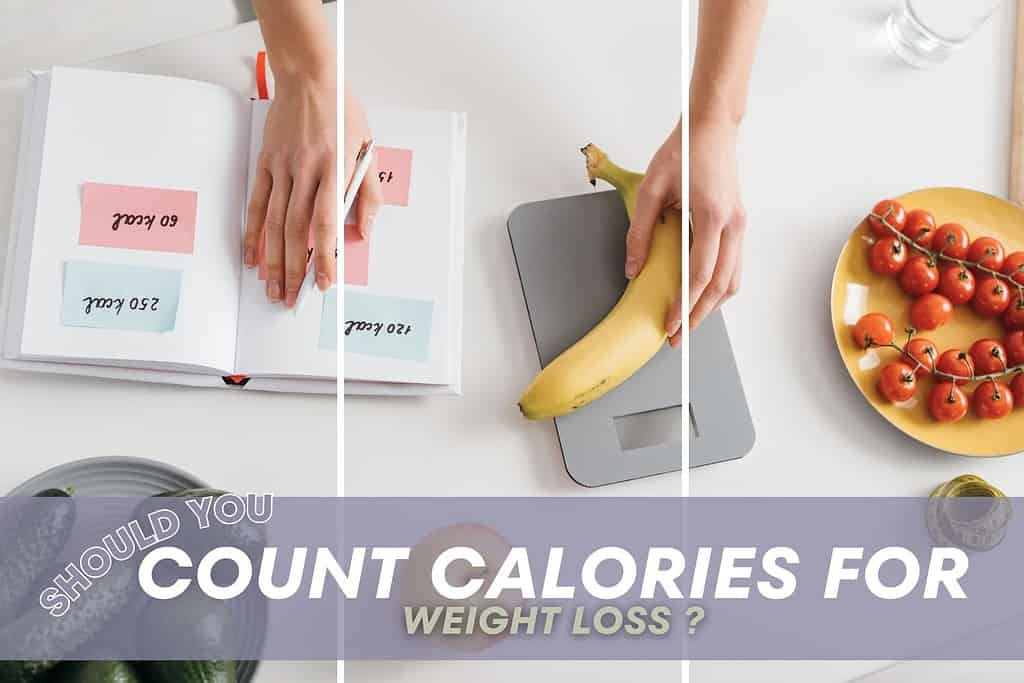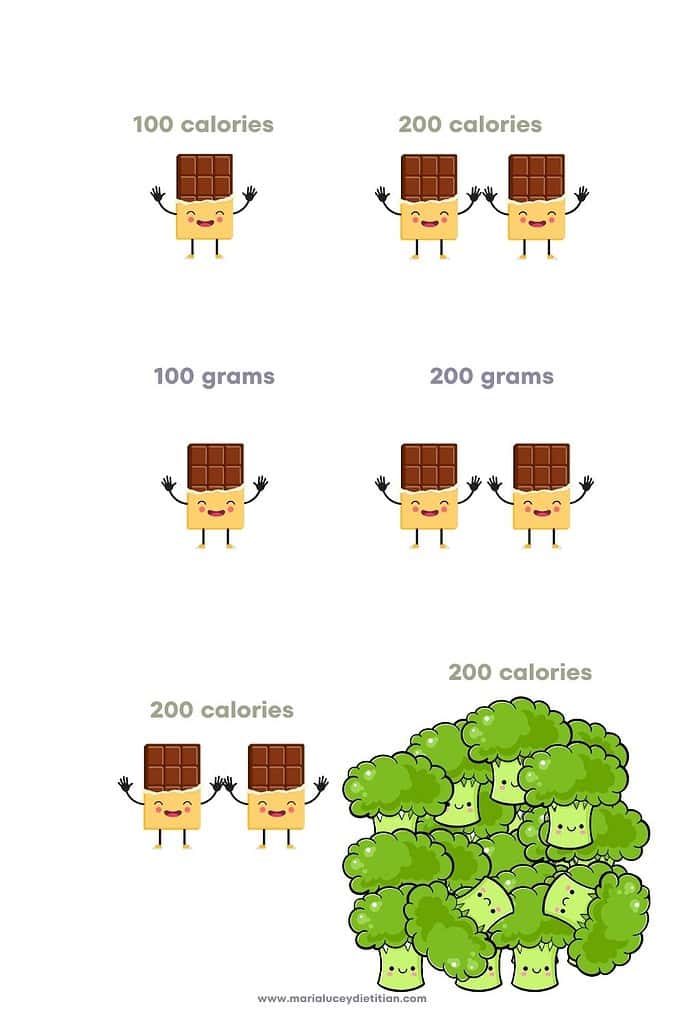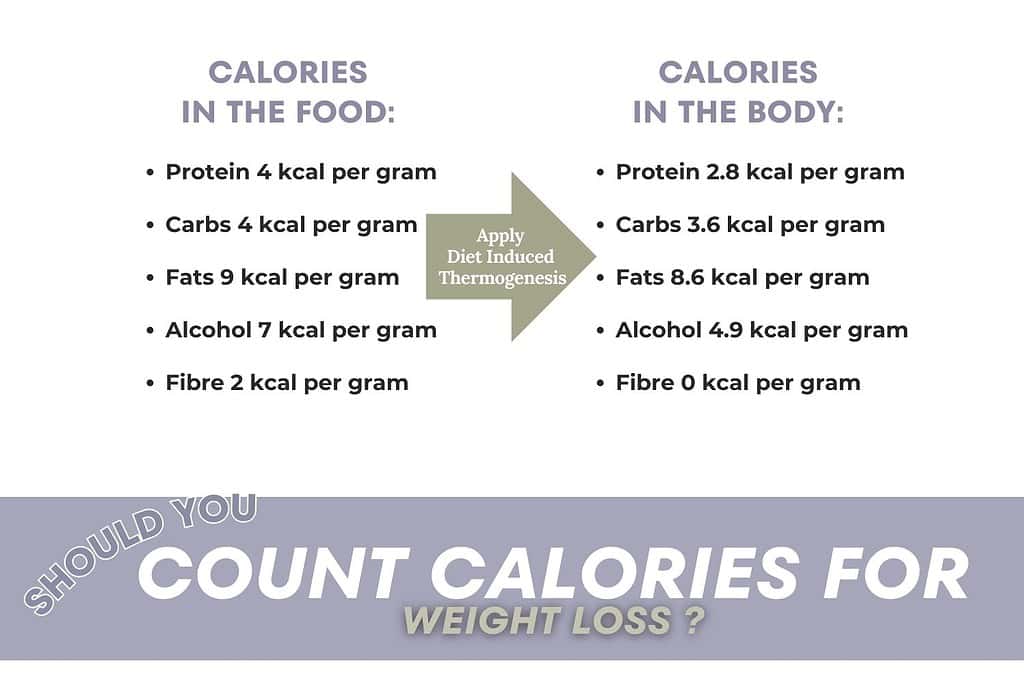It is true that we need to eat fewer calories to lose weight, BUT calorie counting can be highly inaccurate. Understanding the nuances will help you know when to take calories seriously and when to take them with a pinch of salt.

Yes, in some cases, calorie counting can work and can be a useful tool. But there are a few reasons why it’s not an approach that, as a dietitian, I often recommend.
In this article, I will help you decide whether or not to count calories as an approach to weight loss or overall health.
If you would prefer to sit back and listen/watch this information, you can check out the YouTube video below:
Calories Count To An Extent
Clearly, calories matter to a certain extent. For instance, 200 calories of chocolate is twice as many as 100 calories of chocolate. Similarly, 200 grams of chocolate is twice as much as 100 grams of chocolate.

But would you compare 200 calories of chocolates to 200 calories of broccoli?
Not really.
Calorie Counting and Disordered Eating
The main reason I don’t recommend calorie counting routinely is because when people start counting calories, it can completely and utterly destroy their relationship with food.
Food is not just a number. It is a delicious thing that not only helps us stay alive but also keeps us nourished and healthy. Counting calories can easily lead to disordered eating habits, and it can happen so quickly that the individual may not even realize it.
Having a healthy relationship with food is extremely important. It's not something to be overlooked. Doing anything that may jeopardise this relationship needs to be carefully considered beforehand. If you are working with a dietitian, they can help you decide whether or not this is an approach that you should consider.
Why Is Calorie Counting Inaccurate?
Diet-Induced Thermogenesis
Let's start at the beginning.
Are you counting calories as they appear on your plate? Or are you counting calories when they've gone into your body and are digested and ready to be used?
It takes energy or calories to break down and use every food you eat. The body needs to ingest, eat, digest, break down, and metabolize the food you eat into something that can be used by the body. This all requires calories. So, it takes calories to break down foods and use them.

This whole process is called “diet-induced thermogenesis” because it is an effort for your body, and it makes you hotter doing the work.
Protein requires the most energy for the body to break down and metabolise. It’s a more in-depth process, taking a bit longer and therefore using up more energy. Fat requires the least amount of energy for our body to digest and is easily utilised by the body.
But are we going to look at each food we eat and readjust the calories based on the amount of energy our body will need to use to break it down? No, of course not; it's not practical and very few people will have time for that. In general, in healthy people with a mixed diet, this “diet-induced thermogenesis” represents about 10% of the total amount of energy ingested over 24 hours. So, in other words, 10% of the calories we eat are burned off digesting the food we eat in a mixed diet.
Caloric Availability
The Sweetcorn Test
My food for thought to get you thinking about caloric availability is the concept of the sweetcorn test. Have you ever eaten sweetcorn in a salad or corn on the cob and then a few hours or days later saw the sweetcorn in your stool?
If you're reading the nutrition label on a can of sweetcorn and it says it contains 100 calories, but then you notice later on that most of it has passed through your body, does that mean that all those calories were actually absorbed? It seems logical that if you can see the corn in your stool, then not all of it is available for your body to use.
So, this is what I mean by caloric availability.
This differs so much between different foods, and many things impact it, but you can see how counting calories becomes even more inaccurate when we take this into account.
So, in order to digest our food, we must:
- Mechanically break it down into tiny pieces (through our teeth, for example) so that it can be:
- Chemically broken down by digestive juices.
Take sweet corn again as an example.
When corn is turned into tortillas, it's mechanically broken down for you. So it's broken down into flour and then shaped into a tortilla. So it's tiny pieces already. All the body really needs to do then is to break it down by digestive juices chemically, and that's why you don't see bits of sweet corn in your stool when you eat tortillas.
Therefore, most of the calories available in the more processed version (the tortilla) are available to the body. While with whole sweet corn, not all of the calories are available.
So, if you're looking at calories per 100 grams, the sweet corn will have less than the tortilla.
How Are Calories Calculated?
When scientists are trying to figure out the calories in a food, they light it on fire in a lab and extract all the energy from it. Then, they can tell us how much energy is in 100 grams of the food. However, extracting energy from food in a lab is a very different process from what happens in your digestive system.
Take nuts as an example. In a lab, they are extracting all the calories from the nuts. Using almonds as an example, one serving contains 170 calories.
However, the energy we obtain from almonds in the lab vs when we eat them is very different. When we eat nuts, due to their structure, we can't extract all the calories from them. In fact, about 30% of the calories end up in the toilet. We only absorb about 129 calories from one serving of almonds, despite the nutrition label telling us it contains 170 calories.
This is important because many of us will look at the back of a pack of nuts and think, "These nuts are super high in calories", but really, we need to be taking off 30% as we are not accessing 100% of the calories.
Now, think of it another way: when we chop up and cook our foods, we are already partially digesting them. As mentioned earlier, digestion involves (1) mechanically breaking down food into smaller bits and (2) chemically digesting food with digestive juices. Therefore, when we chop our food and then cook it, that is partially digesting it.
Now, think of this from a calorie availability point of view. When you chop and cook your food, the calories are now more available because you have already started the digestion process. The chopping and cooking process has already started mechanically breaking down your food.
So, when you're thinking of counting calories, people tend to count them like a simple math equation. But really, if you eat 2000 calories of processed food and 2000 calories of whole foods, the 2000 calories of processed food are more available.
Now, you can consider diet-induced thermogenesis again in the same conversation as caloric availability. The more a food is processed, the easier it is for the body to break it down and use it. As a result, less diet-induced thermogenesis is going to come into play for that food.
There was one study done that found that the body burns nearly 50% fewer calories digesting a meal of processed foods than a meal of whole foods despite both containing the same ‘theoretical’ calories.
Not only that but since it doesn't take much energy to digest these foods, you're likely to be hungry again sooner after eating them compared to whole foods. It takes longer for Whole Foods to leave your belly and your intestines compared to the processed foods, which are quickly digested.
Think of it logically: An apple takes longer to eat, and it's way more filling than apple sauce, which itself is more satiating than a glass of apple juice.
Gut Microbiome
Another secret weapon in all of this calorie talk is our gut microbiome, the collection of bacteria, viruses and fungi that live in our gut.
Our gut bacteria and the chemicals they produce (e.g., short-chain fatty acids) can impact our appetite. They can delay the release of our hunger hormone (ghrelin) and increase the level of our satiety hormone (leptin). Other chemicals produced by our gut microbiota are thought to target the reward network in our brain, which influences our relationship with food and our tendency towards emotional eating.
Micronutrients:
Another point is that if a food is highly processed, it can reduce the nutrients within the food.
This is a blanket statement and isn’t always true. But the nutrients within the food do often change when you process it and turn it into a more processed food.
So you could argue that the whole foods dietary approach actually provides fewer calories but more vitamins, minerals and nutrients.
Accuracy Of Calories On Labels:
Calories on menus and nutrition labels are never fully accurate. In fact, legally, companies are allowed a 20% error margin.
Conclusion:
So, all in all, counting calories is very inaccurate. And this is why, apart from the risk of ruining your relationship with food by counting calories, I don't often get people to do it.
Counting calories once in a while can be helpful for SOME people, but I really say some here as a person’s relationship with food can be a fragile thing, and pros and cons need to be considered.
Sometimes, it can help people become more aware of what they are eating when they are trying to lose weight. For example, you might realise that the salad dressing you thought was healthy is actually adding 300 calories without you realising it. But there are other ways to do this than just counting calories; it could be keeping a food diary or taking pictures of what you eat and asking your dietitian to review it.
My Approach
It's often more helpful to pay attention to the nutritional content of your food rather than just the calories. Considering how you are structuring your meals and snacks throughout the day and whether your meals and snacks are balanced is often a more helpful approach.
We are all so different and have varying nutritional needs. If you focus your counting attention elsewhere rather than on calories, you will be making healthier food choices by default. Think about eating enough protein, more fibre, less sugar and enough calcium for your bones.
This article was all about calorie counting and its inaccuracies.
Connect with Maria Lucey, RD!
Don’t forget to follow me on Instagram, YouTube, and Pinterest so you never miss a new recipe or blog post.
Recipes You May Also Enjoy:
- 💫The Original Baileys Cheesecake Recipe – Irish Cream No-Bake Cheesecake
- 💫Almond Butter Energy Balls Recipe
More about the author:
Hi there! My name is Maria, and I am a Registered Dietitian practising in Ireland and Bermuda. I have extensive experience in helping clients improve their health through the power of good nutrition. I hope you enjoyed this recipe. If you have any questions or concerns, please do not hesitate to contact me. Additionally, if there are nutrition topics or recipes you would like me to make in future posts, please let me know. I would be more than happy to help.
Stay happy and healthy 💚
Your Registered Dietitian
Maria xx
Check me out on YouTube!
🎥 Visit my YouTube Channel to learn more about my approach to eating and see many of my healthy recipes.





Leave a Reply